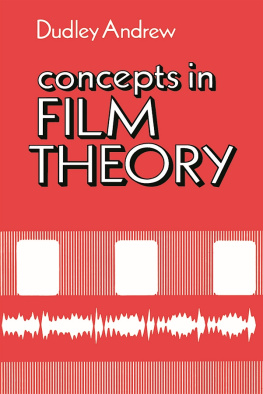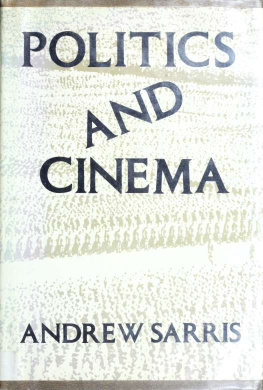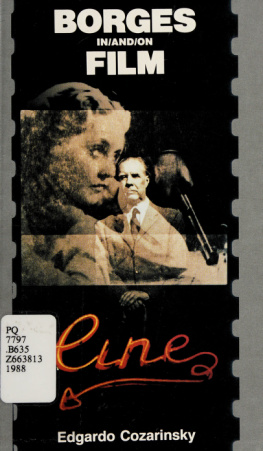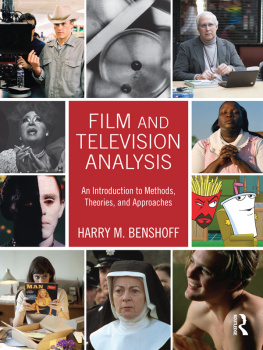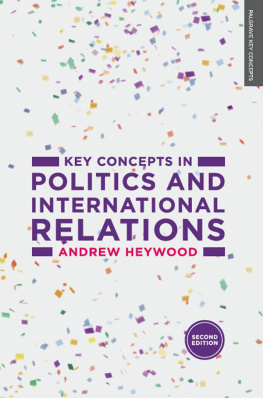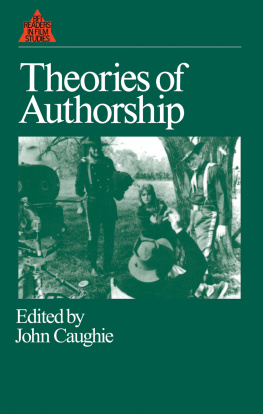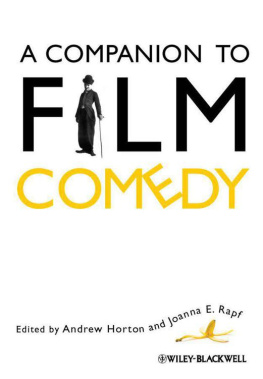Andrew - The major film theories: an introduction
Here you can read online Andrew - The major film theories: an introduction full text of the book (entire story) in english for free. Download pdf and epub, get meaning, cover and reviews about this ebook. City: USA;London, year: 1976;2011, publisher: Oxford University Press, genre: Science. Description of the work, (preface) as well as reviews are available. Best literature library LitArk.com created for fans of good reading and offers a wide selection of genres:
Romance novel
Science fiction
Adventure
Detective
Science
History
Home and family
Prose
Art
Politics
Computer
Non-fiction
Religion
Business
Children
Humor
Choose a favorite category and find really read worthwhile books. Enjoy immersion in the world of imagination, feel the emotions of the characters or learn something new for yourself, make an fascinating discovery.

The major film theories: an introduction: summary, description and annotation
We offer to read an annotation, description, summary or preface (depends on what the author of the book "The major film theories: an introduction" wrote himself). If you haven't found the necessary information about the book — write in the comments, we will try to find it.
The major film theories: an introduction — read online for free the complete book (whole text) full work
Below is the text of the book, divided by pages. System saving the place of the last page read, allows you to conveniently read the book "The major film theories: an introduction" online for free, without having to search again every time where you left off. Put a bookmark, and you can go to the page where you finished reading at any time.
Font size:
Interval:
Bookmark:
An Introduction
J. Dudley Andrew
The University of Iowa

OXFORD UNIVERSITY PRESS
Oxford London Glasgow
New York Toronto Melbourne Wellington
Nairobi Dar es Salaam Cape Town
Kuala Lumpur Singapore Jakarta Hong Kong Tokyo
Delhi Bombay Calcutta Madras Karachi
Cover design based on sketches of film Alexander Nevsky by Sergei Eisenstein from The Film Sense by Eisenstein, translated and edited by Jay Leyda, copyright, 1942, 1947, by Harcourt Brace Jovanovich, Inc.; renewed, 1970, 1975, by Jay Leyda.
Reproduced by permission of the publishers.
Thanks are due to the University of California Press for permission to quote from the following:
Art and Visual Perception by Rudolf Arnheim, copyright 1954 by The Regents of the University of California
What Is Cinema?, I, by Andr Bazin, copyright 1967 by The Regents of the University of California
What Is Cinema?, II, by Andr Bazin, copyright 1971 by The Regents of the University of California.
ISBN-13 9780-19501991-9
Copyright 1976 by Oxford University Press, Inc.
Library of Congress Catalogue Card Number: 7525465
First published as an Oxford University Press paperback, New York, 1976
Printed in the United States of America
for my mother and father
from whom.
There have been, to my knowledge, two histories of film theory: Guido Aristarcos Storia delle teoriche del film and Henri Agels Esthtique du cinma. While I am indebted to these works, I have no wish to emulate them in their attempts to list every theorist and disentangle each line of theory.
Instead this book hopes to set off the major theorists one against the other, forcing them to speak to common issues, making them reveal the basis of their thought. I have chosen, therefore, those theorists who wrote about film in a broad sense, and who did so with the force of extended argument. The countless thinkers who have on occasion theorized about cinema (including great thinkers like Panofsky, Susanne Langer, Maurice Merleau-Ponty, Gabriel Marcel, and Andr Malraux) receive hardly any attention here. Primitive theorists like Ricciotto Canudo, Louis Delluc, and Vachel Lindsay are also slighted because, in my estimation, their theories do not bear the weight of comparison with the other figures in this book.
Priority has been given to those theorists whose writings are readily available in English. Unfortunately this eliminates from discussion major theorists in French, in Russian, and especially in Italian. Since this volume is intended as an aid to, not a substitute for, the reading of the theorists themselves, an extended treatment of figures whose books are both difficult to obtain and untranslated as well seems off the point. True, the final chapters of this book do deal with some contemporary French theorists whose work is still in French, but this seems warranted since their ideas are in the current marketplace and, in several instances, in the process of translation.
The scheme of this book does have some historical appearance, but only incidentally. I retain the classic distinction between formative theory and realist or photographic theory, a distinction which is commonplace and which is related to the clich that all cinema has roots in either Mlis or Lumire. In film theory it so happens that the first great age of thought was nearly homogeneously formative. Until 1935 or so it is difficult to find a realist capable of standing up against Hugo Munsterberg, Rudolf Arnheim, Sergei Eisenstein, Bla Balzs, or V. I. Pudovkin. Then the situation changed, and the seeds of early realist theory grew into the lush tradition of Andr Bazin, the Cahiers du cinma critics, and in America of Siegfried Kracauer and cinma-vrit artists like Richard Leacock, D. A. Pennebaker, and Michael Roemer.
It is valuable to set these movements in opposition since that is in fact exactly how they developed. The formative theorists wrote in answer to the brute realism which film producers advertised and which the public thought it was receiving. Later, the realists specifically attacked the formalists because they tossed out cinemas special call to realism as they tried to make it stand alongside the prestige arts.
Again it must be emphasized that no attempt has been made here to include every thinker in each camp. Instead, I have chosen those thinkers who best articulate a position which has behind it either extensive thought or an important tradition. By working back to this tradition or to this core, I hope to give the reader some footholds with which he can more easily and more successfully climb back into the original works. It will become apparent that while the formative thinkers, for instance, concur on many, indeed most, issues relating to film, their reasons for holding such positions and their arguments sustaining those positions vary enormously. While most film students may be ready to compare theories as divergent as Eisensteins and Bazins, it seems more fruitful to me to compare theorists of the same camp. This book is meant to promote such comparison.
The final section of the book deals with contemporary theory, with the thought which, at the moment of my writing, is still developing, still working toward a final formulation. For the most part contemporary theory has tried to bypass the formative/realist debate either by incorporating both camps in a dialectic, as Jean Mitry has done, or by lifting the discussion to a level of abstraction where that distinction is no longer quite so pertinent (as both the phenomenologists and semiologists have done to some extent). Because of the wealth of current theory and its rather confused state I have restricted myself to works done in France, where, despite the diversity of approaches, there is a sense of debate and of common concerns. This final section will at best provide the reader with a series of signposts by which he can recognize the major issues and consider the various positions in the light of classical film theory.
Here, too, some figures will be missed, figures who may seem or may become important. But what interests me and what should interest all film scholars and students is the project of film theory itself, not the classification of each and every theorist. Even if what follows were an exhaustive treatment of all film theories, it would be foolish for the reader to put down this book with the relieved sense of having ingested a summary of what has been thought about film. I would have him instead begin to theorize on his own, inspired (though never restricted) by the men and arguments which have gone before him.
Every book requires a time and a place to be written. I would like to acknowledge the National Endowment for the Humanities for giving me the time to organize and articulate these essays. The University of Iowa with its tradition of serious theoretical study of film (marked by more than a dozen dissertations in this area) provided an atmosphere of encouragement. Dr. Sam Becker has been the active embodiment of that encouragement and the very image of that tradition of theory.
Most centrally I must acknowledge the five years of extraordinary students who have peopled my courses in film theory and who helped me reach the insights and comparisons these essays may attain. Let me cite especially several former graduate students, most of whom are now teaching film theory themselves, whose papers and discussions brought me to the understanding of one figure or another. Donald Fredericksons clear and rigorous treatment of Hugo Munsterberg made me aware of the power of his little-known theory and of the complex tradition supporting it. Jeffrey Bacal and James Spellerberg made me face aspects and issues in the thought of Eisenstein which have become central to my vision of the great Russian. Brian Lewis and David Bordwell supported and broadened immeasurably my view of Jean Mitry.
Font size:
Interval:
Bookmark:
Similar books «The major film theories: an introduction»
Look at similar books to The major film theories: an introduction. We have selected literature similar in name and meaning in the hope of providing readers with more options to find new, interesting, not yet read works.
Discussion, reviews of the book The major film theories: an introduction and just readers' own opinions. Leave your comments, write what you think about the work, its meaning or the main characters. Specify what exactly you liked and what you didn't like, and why you think so.

